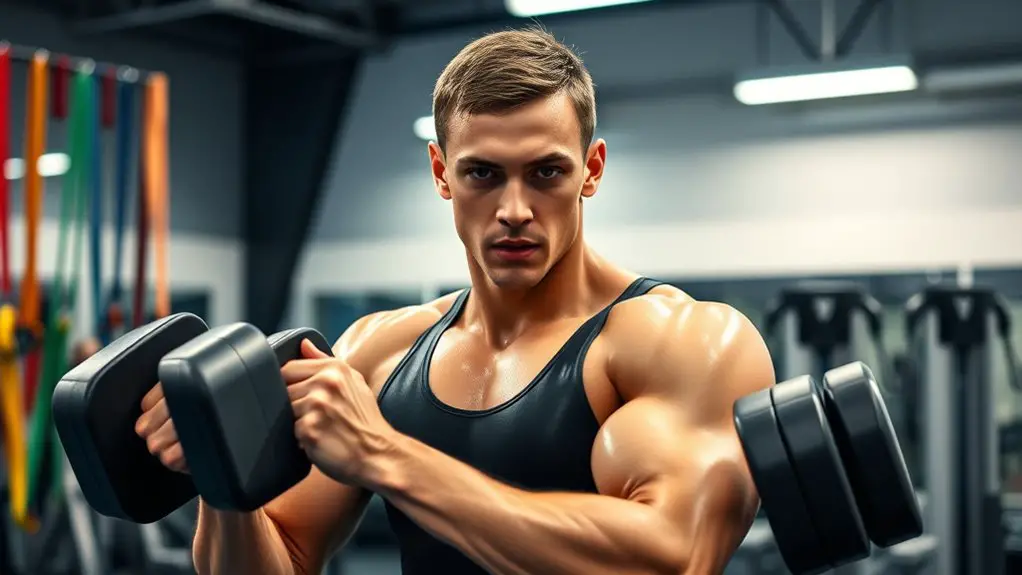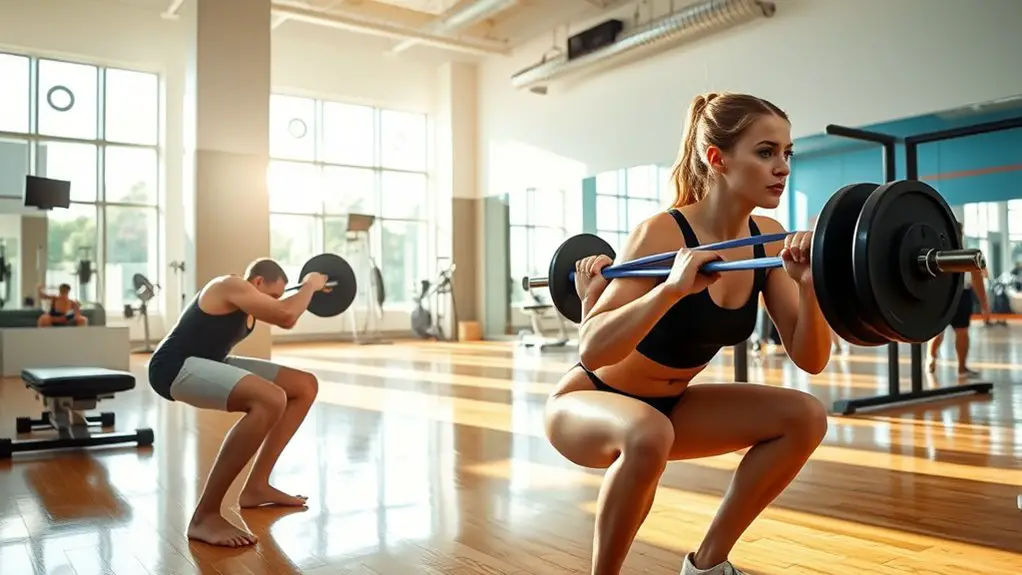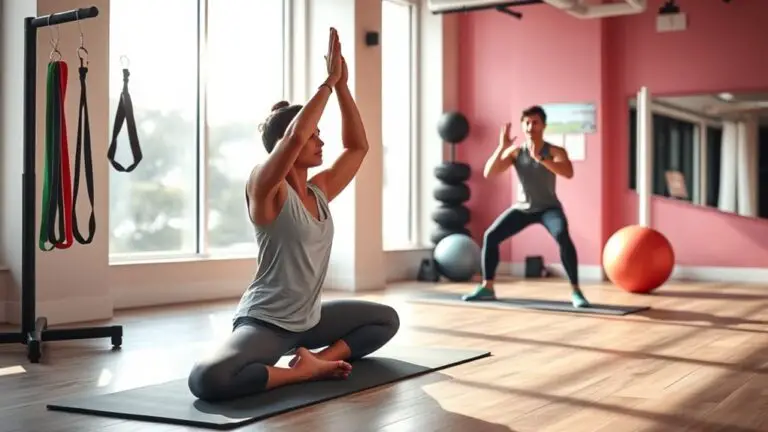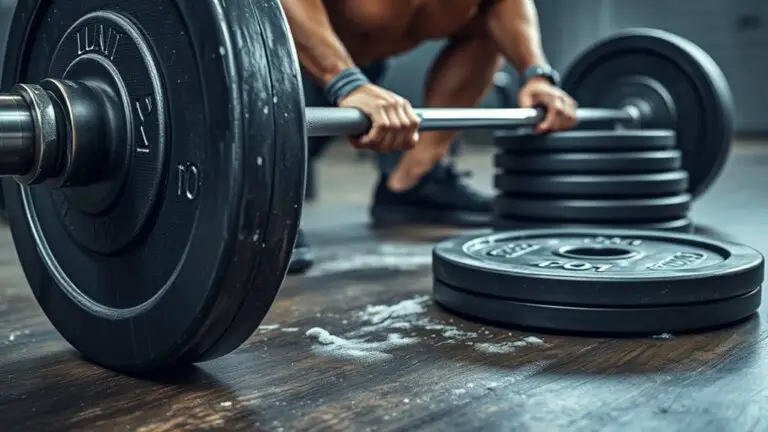How Swimmers Use the Gym for Strength Training

As a swimmer, you use the gym to build strength and enhance performance. Focusing on key muscle groups—upper body, core, and legs—improves stroke power and balance. Essential exercises, like squats and resistance band work, boost efficiency in water. You create a balanced program that emphasizes injury prevention and monitors progress through consistent evaluations. By pushing your limits and adapting your training, you not only prevent plateaus but also reveal new levels of performance. Discover more insights to elevate your swim training.
The Importance of Strength Training for Swimmers

When you plunge into the world of competitive swimming, you may not immediately think of strength training as part of your regimen. However, integrating strength training is essential for enhancing your performance. It complements your endurance training by building the muscular power necessary for powerful strokes and faster turns.
Incorporating flexibility exercises into your routine is equally important; they improve your range of motion, allowing for more efficient swimming mechanics. A well-rounded strength program focuses not only on building muscle but also on maintaining flexibility, which helps prevent injuries.
Key Muscle Groups for Swimmers
To excel in swimming, you need to focus on developing key muscle groups that enhance your performance. Upper body strength is essential for powerful strokes, while core stability guarantees efficient movement and balance in the water. Additionally, leg power development will propel you through each kick, maximizing your speed and efficiency.
Upper Body Strength
Upper body strength is essential for swimmers, as it directly influences performance and efficiency in the water. Your arms and shoulders are critical for propelling yourself through various swim strokes, making targeted upper body exercises fundamental. Focus on compound movements like pull-ups, bench presses, and rows to build muscle mass and power. These exercises enhance your pull and recovery phases, enabling a more effective stroke. Incorporating resistance bands can also improve your shoulder stability, which is key for injury prevention. Remember, stronger upper body muscles translate to better speed and endurance in the pool. Stay consistent with your training, and you’ll notice significant improvements in your swim performance, giving you the edge you need to excel.
Core Stability Enhancement
While many swimmers focus on upper body strength, core stability is equally essential for optimizing performance in the water. A strong core facilitates better body positioning, which directly impacts your efficiency and speed. Engaging your core during every stroke helps maintain balance and reduces drag, allowing you to glide through the water more effectively. Incorporating stability exercises, such as planks and medicine ball rotations, can markedly enhance your core engagement. These exercises not only strengthen the muscles around your abdomen but also improve your overall coordination and power transfer from your upper to lower body. Prioritizing core stability in your training can lead to improved performance, ensuring you’re not just strong but also stable and streamlined in the pool.
Leg Power Development
Building on the importance of core stability, leg power plays a pivotal role in a swimmer’s performance. To maximize your speed and efficiency in the water, focus on developing key muscle groups through targeted strength training. Incorporating squat variations like front squats and single-leg squats helps enhance your quadriceps, hamstrings, and glutes, providing a strong foundation for explosive starts and turns. Additionally, plyometric drills, such as box jumps and jump squats, can greatly improve your leg power and overall agility. These exercises not only build strength but also train your muscles to react quickly, essential for powerful propulsion in the water. By integrating these techniques into your routine, you’ll elevate your swimming performance and achieve your competitive goals.
Essential Weightlifting Exercises
Incorporating essential weightlifting exercises into your training regimen can greatly enhance your swimming performance. Focus on compound movements that target multiple muscle groups, like barbell squats. These not only build strength in your legs but also engage your core, critical for maintaining stability while swimming. As you drive power off the blocks and during each stroke, this strength translates directly to your performance in the water.
Additionally, resistance bands are invaluable for improving your technique and muscular endurance. Use them for exercises like banded pull-aparts or lateral walks to activate your shoulders and hips, which are essential for effective swimming strokes. By integrating these essential exercises, you’ll develop a well-rounded strength profile that supports explosive starts and sustained speed. Remember, consistency is key, so make these lifts a staple in your routine, and you’ll see noticeable improvements in your swimming over time.
Resistance Training Techniques

To maximize your strength training benefits, it’s essential to employ a variety of resistance training techniques tailored for swimmers. One effective method is circuit training, which allows you to combine multiple exercises targeting different muscle groups while minimizing rest periods. This not only enhances your endurance but also promotes muscle growth.
Incorporating resistance bands can further elevate your training. They provide variable resistance, allowing you to focus on specific muscle activation while improving your stability and flexibility. By integrating bands into your circuit training, you can simulate the resistance encountered in water, making your workouts more applicable to your swimming performance.
Mixing these techniques keeps your workouts engaging and effective. Aim for a balanced approach, targeting both upper and lower body muscles, and don’t forget to adjust the resistance levels based on your progress. Embrace these methods, and you’ll see significant improvements in your strength and overall swimming capabilities.
Creating a Balanced Training Program
While developing a balanced training program, it’s vital to contemplate the unique demands of swimming and the specific muscle groups involved. To optimize your strength training, you should integrate periodization strategies that align with your swimming schedule. This guarantees you’re not only building strength but also allowing adequate recovery. Additionally, incorporating exercises like skipping rope can enhance your full-body workout routine, engaging multiple muscle groups and improving cardiovascular health.
| Training Focus | Frequency |
|---|---|
| Upper Body Strength | 2 times/week |
| Lower Body Strength | 2 times/week |
| Core Stability | 3 times/week |
| Endurance Training | 1-2 times/week |
Aim for a training frequency that complements your swim workouts, allowing you to target all muscle groups effectively. By adjusting your program to include varied intensity levels, you can enhance performance while minimizing fatigue. Remember, a well-balanced approach fosters not just strength but also overall athleticism, helping you excel in the pool.
Injury Prevention Through Strength Training

Strength training plays an essential role in injury prevention for swimmers, as it strengthens the muscles, tendons, and ligaments that support joint stability. By incorporating targeted exercises into your routine, you can effectively implement injury prevention strategies that reduce the risk of common swimming injuries, such as shoulder and knee issues. Focusing on compound movements, like squats and deadlifts, enhances overall strength and endurance, ensuring your body can withstand the demands of rigorous training.
Additionally, integrating rehabilitation techniques, like resistance band exercises, can further fortify vulnerable areas, promoting better alignment and movement patterns. Engaging in strength training not only builds resilience but also fosters a proactive mindset towards injury management. When you prioritize these strategies, you’re not just swimming faster; you’re also laying the groundwork for a longer, healthier athletic career. Remember, strong muscles and joints lead to fewer setbacks, allowing you to focus on your performance and goals.
Monitoring Progress and Making Adjustments
As you commence your strength training journey, monitoring progress and making adjustments is essential for optimizing performance and achieving your goals. Effective progress tracking helps you identify what’s working and what isn’t, guaranteeing you stay on the right path. Here are three key adjustment strategies to contemplate:
- Regular Assessments: Schedule bi-weekly evaluations to measure strength gains, endurance improvements, and technique refinement. Use a journal or app to log your workouts.
- Feedback Loops: Seek feedback from coaches or training partners. They can provide valuable insights on your form and workout intensity, which can guide your adjustments.
- Progressive Overload: Gradually increase weights or resistance as your strength improves. This guarantees that your muscles continue to be challenged, preventing plateaus and enhancing overall performance.
Frequently Asked Questions
How Often Should Swimmers Incorporate Strength Training Into Their Routine?
Swimmers seeking strength should seriously consider strength training frequency. Ideally, you’ll want to incorporate it two to three times weekly, optimizing your training schedule to balance swimming and resistance work. This allows muscles to recover while enhancing performance. By strategically scheduling these sessions, you’ll not only build power but also promote endurance, making your swimming stronger and more efficient. Remember, consistency is key to achieving your athletic aspirations and revealing your true potential.
Can Strength Training Improve Swimming Speed and Endurance?
Absolutely, strength training can greatly improve your swimming speed and muscle endurance. By enhancing your power output through targeted workouts, you’ll generate more force during each stroke. This increased strength translates into faster times and greater stamina in the water. When you build muscle endurance, you’re able to maintain ideal performance throughout your swim, reducing fatigue. So, incorporating strength training into your routine isn’t just beneficial; it’s essential for achieving your swimming goals.
What Are Common Mistakes Swimmers Make in the Gym?
When you hit the gym, it’s easy to fall into common traps that can hinder your progress. Many swimmers overtrain, pushing their bodies too hard without adequate recovery, which increases the risk of injury. Additionally, using improper form can negate the benefits of your workout while placing unnecessary strain on your joints. By focusing on technique and balancing your training intensity, you’ll optimize your strength-building efforts and enhance your overall performance in the pool.
Should Swimmers Focus on Free Weights or Machines?
When deciding whether to focus on free weights or machine strength, consider your goals. Free weights offer greater functional strength and stability, which can translate well to swimming performance. They engage multiple muscle groups and improve coordination. However, machines can be beneficial for isolating specific muscles and ensuring proper form. A balanced approach, incorporating both methods, can enhance overall strength and prevent injuries. You’ll find what works best for you through experimentation and consistency.
How Do Nutrition and Strength Training Complement Each Other for Swimmers?
Imagine your body as a finely-tuned engine; without the right fuel, it won’t run efficiently. For swimmers, nutrition timing is essential. Consuming recovery meals packed with protein and carbs right after training helps repair muscles and replenish energy stores. This synergy between nutrition and strength training enhances performance, allowing you to push harder in the pool. When you prioritize both, you’re not just training; you’re optimizing your potential for success.





